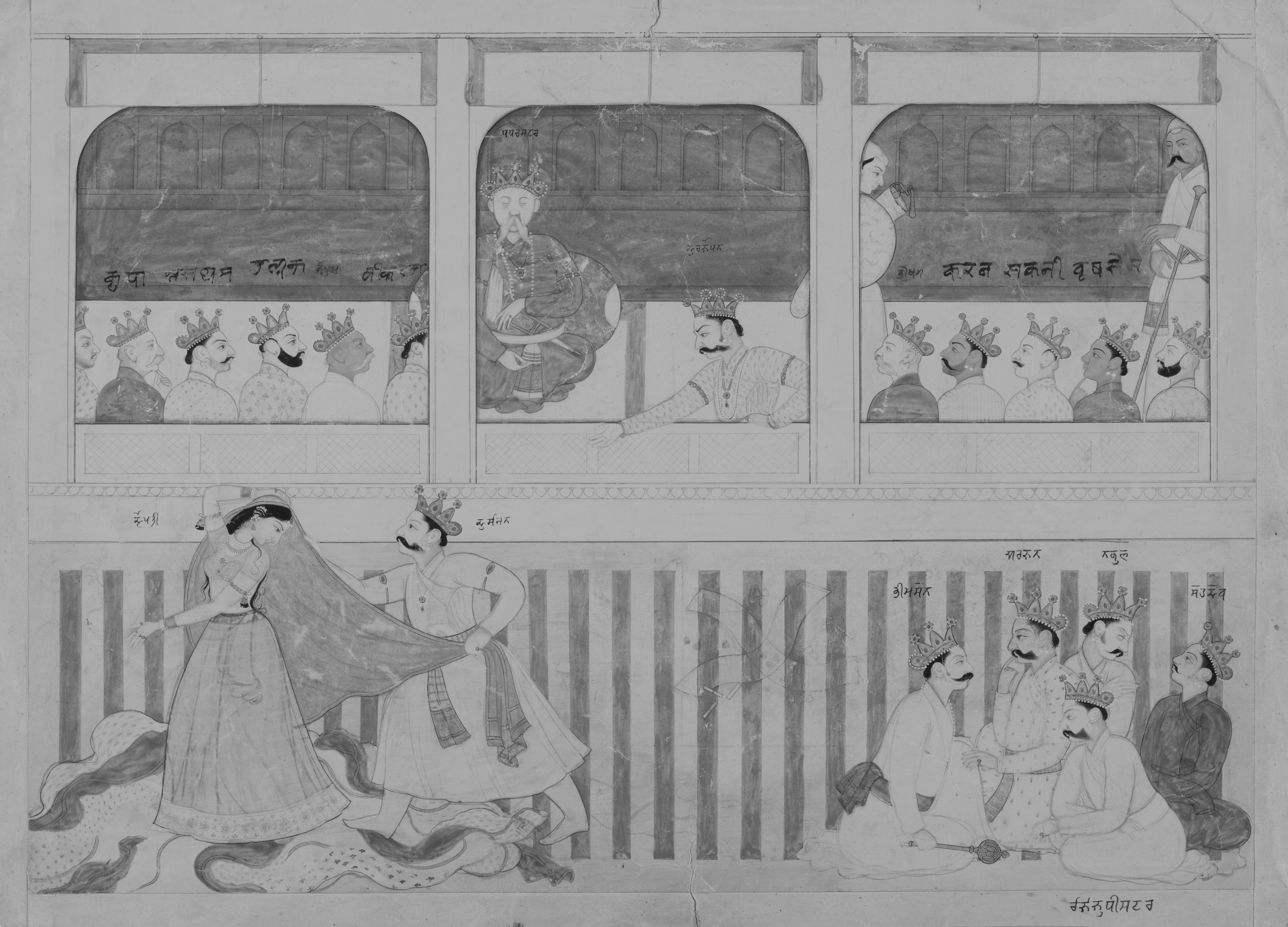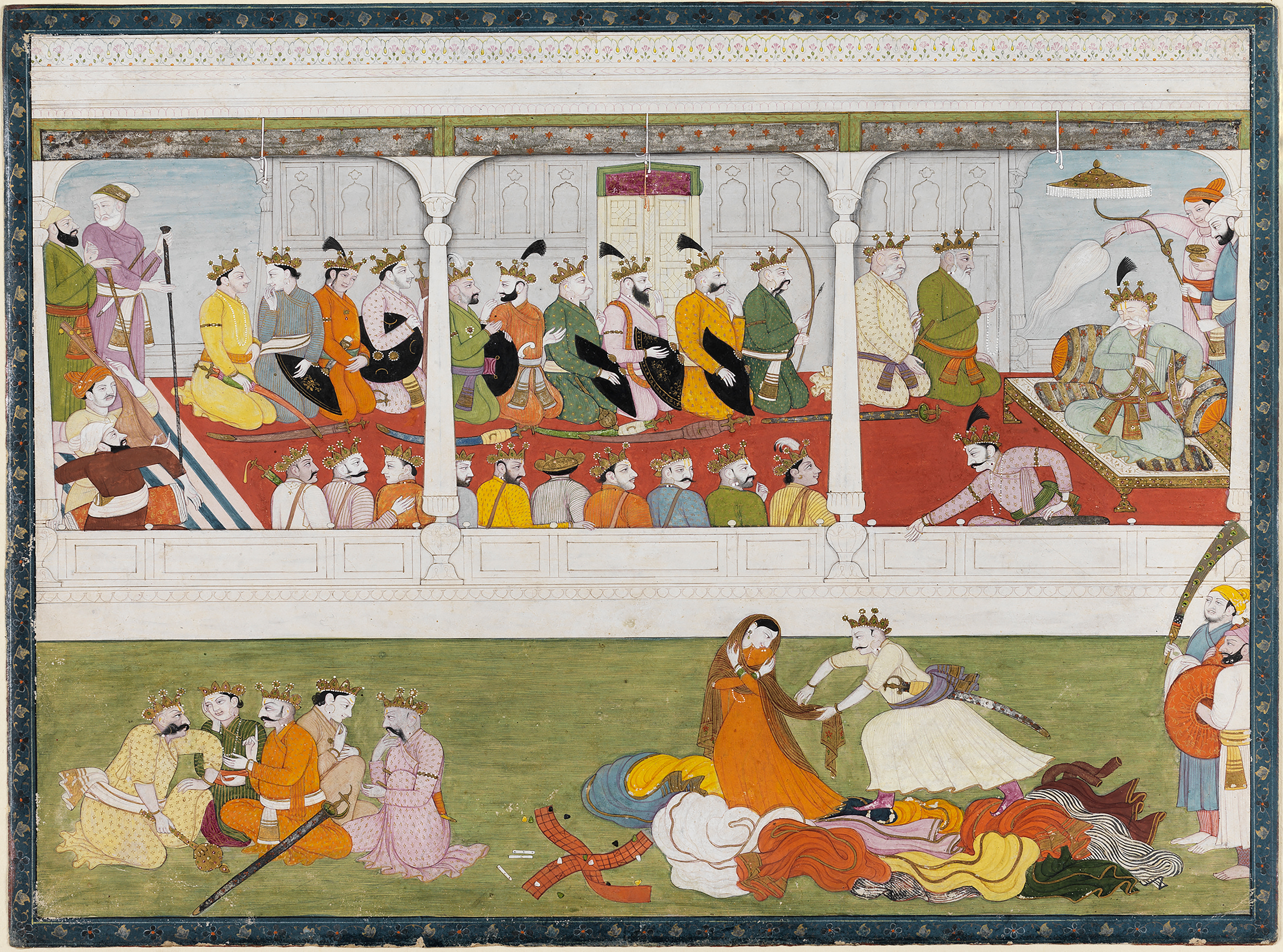
This painting, dated around 1760–65, is attributed to the Indian painter Nainsukh, who was active in the small court of Guler at the hills of the Himalayas circa 1735–78.
Nainsukh remains one of the most influential artists of early modern Indian art and is admired for the originality and effectiveness of his compositions. Relatively few of the works created by the celebrated artist have been unequivocally ascribed to him, and an even smaller number contain a signature. Such is the case of the painting under study.
Little research has been conducted on the technical aspects of paintings attributed to Nainsukh. This line of study, however, has the potential to contribute significantly to the understanding of his creative process. Technical inquiries might also reveal aspects of his technique, placing his work within the broader context of the Pahari school of painting.
This folio, The Disrobing of Draupadi, is created over a sheet of wasli, a multilayered, handmade paper that has been prepared and polished to paint with opaque watercolors. It depicts an episode from the Hindu epic poem, the Mahabharata, a central moment in the struggle between two groups of cousins who compete for the throne of Hastinapur.
The episode precipitates the tragic war recounted in the poem: the Kurukshetra War, also known as the Mahabharata War. Draupadi, the central character of this painting, is married to the Pandava brothers, who have been tricked by their cousins, the Kauravas, into a rigged game of dice.
Persuaded by the Kauravas’ cunning invitation, the Pandavas bet all they have in the game—their wealth, their own freedom, and finally also their wife’s. When the game is over, they sit powerless and humiliated, crushed by the fact that they have lost everything in a reckless act of gambling.
Dushasana, drunk with power after outsmarting the Pandavas, attempts to strip Draupadi of her clothes (an event known as cheer-haran), but when she realizes that her husbands won't help her, she prays to Lord Krishna to spare her dignity.
A miracle takes place.
As her garments are taken away, more garments appear again and again, yards of fabric piling up at her feet.
The upper half of the composition is occupied by members of the Kaurava family, presided over by the blind king Dhritarashtra.
At the center-right of the arcade stands Duryodhana, the main conspirator, who has commanded his brother Dushasana to bring Draupadi into the court.
The characters in the painting are identified with small inscriptions in the local Takri script.
The lower half of the painting is defined by the distinctive design of a rug with vertical red and brown strips.
Scientific analysis of this area confirms a watercolor palette that is consistent with the traditions of the Pahari school of painting in the 18th century. Raman spectroscopy confirmed the use of vermillion to obtain a bright red orange that sets the ground, followed by slightly translucent strips of a dark maroon color obtained with hematite.
This bold yet elegant device is used by Nainsukh in other paintings from the same period.
.jpg?sc_lang=en&hash=1583DFED4D24FF5B51A00C780FAA7F32)
Attributed to Nainsukh (Indian). The Poet Bihari Offers Homage to Radha and Krishna Opening page separated from a manuscript of the Satasai Seven Hundred Verses, ca. 1760–65. Opaque watercolor, gold, and silver-colored paint on paper, Image: 7 3/8 × 10 3/4 inches (18.7 × 27.3 cm) Sheet: 9 3/4 × 12 7/8 inches (24.8 × 32.7 cm), Philadelphia Museum of Art, Philadelphia, 125th Anniversary Acquisition. Alvin O. Bellak Collection, 2004 (2004-149-71)
Almost imperceptibly, at the center of the rug lie three very small white, oblong objects.
They are long dice, also known as tabular or stick dice. Although the white paint in some areas is lost, revealing the red color of the layer underneath, we can see that the black dots on the three dice sum a total value of five, perhaps a reference to the five Pandava brothers.
These three unassuming dice carry the tragic symbolism of the entire incident. They mark Draupadi’s fate, and much more than that, the unbearable humiliation that ultimately leads to the Mahabharata War.
A closer look at this center area offers an opportunity to investigate Nainsukh’s creative process.
Passages in the red and brown watercolor of the rug are eroded, partially revealing a form outlined in white and other colors that appear to have been brushed in before the painting was finalized, indicating late adjustments in the original composition.




.jpg?sc_lang=en&hash=37DF441ED23F2E9FA5E627DB5D848955)




